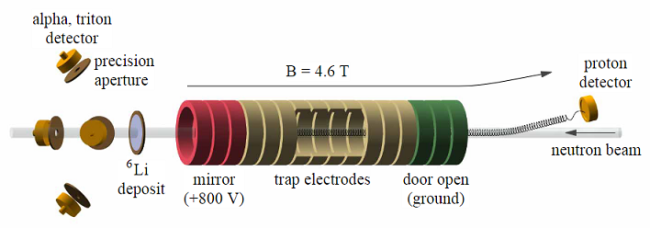Despite reaching this unprecedented precision, the UCNτ work alone did not resolve the outstanding discrepancy between the beam and bottle measurements of the neutron lifetime. Motivated to solve this neutron lifetime puzzle, we recently joined the beam lifetime (BL) collaboration to understand the technical challenges specific to the beam technique. The Beam Lifetime (BL) experiment at NIST measures the neutron lifetime by observing neutron decay in flight. The neutron lifetime is determined by trapping decay protons from beam neutrons in a Penning trap, then comparing the proton trapping rate to the rate of beam neutrons passing through the trap.

The neutron beam passes through this quasi-Penning trap where decay protons are trapped and counted by periodically lowering the door electrodes to the ground. Neutrons are counted via the (n, alpha) reaction in a thin 6LiF deposit.
The BL3 experiment scales up the BL2 experiment, which is currently deployed at the NIST reactor, to reduce the uncertainties of the lifetime measurement. It will improve the counting statistics by increasing the neutron beam diameter from 10 mm to 35 mm. With the interest to solve the neutron lifetime puzzle, we recently joined the BL3 collaboration to address the technical challenges specific to the beam technique.
The responsibilities of our group include:
- Design and construction of the Alpha-Gamma device to calibrate the efficiency of the neutron fluence monitor
- Optimize the Alpha-Gamma device to use of the neutron flux in a new monochromatic beam at NIST.
- Monte-Carlo simulation of protons in the quasi-Penning trap.
- Develop a novel in-situ detection of protons inside the Penning trap & calibrate the efficiency of the external proton detector.
A proposal to construct the apparatus for the next-generation BL3 experiment, including a new magnet, a larger proton trap, and modern detector systems, has just been funded by the National Science Foundation. In our group, we will explore an in-situ proton detection method, using well-established techniques, to detect single protons non-destructively inside the BL Penning trap. As a part of the work, we will investigate the (in)stability of the proton trap. If successful, this work will have high impacts on NIST's active neutron lifetime program using the beam method: until results of the two methods come into agreement, the state of confusion surrounding neutron lifetime will remain.
A recent talk (April 2022) on our BL3 effort to build the Alpha-Gamma device to calibrate the neutron fluence monitor:
Research Opportunities:
The BL3 effort has just been fully funded by the National Science Foundation.
At this point, we are looking for one postdoc, two graduate students, and a few undergraduate research assistants to join this effort. If you are interested, please contact us.
People working on this effort:
- Chen-Yu Liu (PI)
